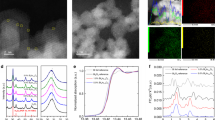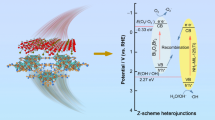Abstract
Heterogeneous photocatalysis has gained substantial research interest in treating per- and polyfluoroalkyl substances (PFAS)-contaminated water. However, sluggish degradation kinetics and low defluorination efficiency compromise their practical applications. Here, we report a superior photocatalyst, defected Bi3O(OH)(PO4)2, which could effectively degrade typical PFAS, perfluorooctanoic acid (PFOA), with high defluorination efficiency. The UV light irradiation could in situ generate oxygen vacancies on Bi3O(OH)(PO4)2 through oxidation of the lattice hydroxyls, which further promotes the formation of Lewis acidic coordinately unsaturated bismuth sites. Then, the Lewis acidic sites couple with the proximal surface hydroxyls to constitute the surface frustrated Lewis pairs (SFLPs). With the in-depth spectroscopic analysis, we revealed that the photo-induced SFLPs act as collection centers to effectively adsorb PFOA and endow accessible pathways to transfer photogenerated holes to PFOA rapidly. Consequently, activation of the terminal carboxyl, a rate-limiting step for PFOA decomposition, could be easily achieved over the defected Bi3O(OH)(PO4)2 photocatalyst. These results suggest that SFLPs exhibit great potential in developing highly efficient photocatalysts to degrade persistent organic pollutants.

Similar content being viewed by others
References
Cordner A, Goldenman G, Birnbaum L S, Brown P, Miller M F, Mueller R, Patton S, Salvatore D H, Trasande L (2021). The true cost of PFAS and the benefits of acting now. Environmental Science & Technology, 55(14): 9630–9633
Ding W, Tan X, Chen G, Xu J, Yu K, Huang Y (2021). Molecular-level insights on the facet-dependent degradation of perfluorooctanoic acid. ACS Applied Materials & Interfaces, 13(35): 41584–41592
Garnett J, Halsall C, Thomas M, Crabeck O, France J, Joerss H, Ebinghaus R, Kaiser J, Leeson A, Wynn P M (2021). Investigating the uptake and fate of poly- and perfluoroalkylated substances (PFAS) in sea ice using an experimental sea ice chamber. Environmental Science & Technology, 55(14): 9601–9608
Ghuman K K, Hoch L B, Szymanski P, Loh J Y Y, Kherani N P, El-Sayed M A, Ozin G A, Singh C V (2016). Photoexcited surface frustrated Lewis pairs for heterogeneous photocatalytic CO2 reduction. Journal of the American Chemical Society, 138(4): 1206–1214
He L, Wood T E, Wu B, Dong Y, Hoch L B, Reyes L M, Wang D, Kübel C, Qian C, Jia J, Liao K, O’Brien P G, Sandhel A, Loh J Y Y, Szymanski P, Kherani N P, Sum T C, Mims C A, Ozin G A (2016). Spatial separation of charge carriers in In2O3−x(OH)y nanocrystal superstructures for enhanced gas-phase photocatalytic activity. ACS Nano, 10(5): 5578–5586
Hoch L B, Szymanski P, Ghuman K K, He L, Liao K, Qiao Q, Reyes L M, Zhu Y, El-Sayed M A, Singh C V, Ozin G A (2016). Carrier dynamics and the role of surface defects: designing a photocatalyst for gas-phase CO2 reduction. Proceedings of the National Academy of Sciences of the United States of America, 113(50): E8011–E8020
Li T, Zhang W, Qin H, Lu L, Yan S, Zou Z (2021). Inorganic frustrated Lewis pairs in photocatalytic CO2 reduction. ChemPhotoChem, 5(6): 495–501
Li X, Yu J, Jaroniec M, Chen X (2019). Cocatalysts for selective photoreduction of CO2 into solar fuels. Chemical Reviews, 119(6): 3962–4179
Li X, Zhang P, Jin L, Shao T, Li Z, Cao J (2012). Efficient photocatalytic decomposition of perfluorooctanoic acid by indium oxide and its mechanism. Environmental Science & Technology, 46(10): 5528–5534
Liu X, Wei W, Xu J, Wang D, Song L, Ni B J (2020). Photochemical decomposition of perfluorochemicals in contaminated water. Water Research, 186: 116311
Lu D, Sha S, Luo J, Huang Z, Jackie X Z (2020). Treatment train approaches for the remediation of per- and polyfluoroalkyl substances (PFAS): a critical review. Journal of Hazardous Materials, 386: 121963
Ma Y, Zhang S, Chang C R, Huang Z Q, Ho J C, Qu Y (2018). Semisolid and solid frustrated Lewis pair catalysts. Chemical Society Reviews, 47(15): 5541–5553
Mumtaz M, Bao Y, Li W, Kong L, Huang J, Yu G (2019). Screening of textile finishing agents available on the Chinese market: an important source of per- and polyfluoroalkyl substances to the environment. Frontiers of Environmental Science & Engineering, 13(5): 67
Ng C, Cousins I T, DeWitt J C, Glüge J, Goldenman G, Herzke D, Lohmann R, Miller M, Patton S, Scheringer M, Trier X, Wang Z (2021). Addressing urgent questions for PFAS in the 21st century. Environmental Science & Technology, 55(19): 12755–12765
Qian Y, Qiao W, Zhang Y (2021). Toxic effect of sodium perfluorononyloxy-benzenesulfonate on Pseudomonas stutzeri in aerobic denitrification, cell structure and gene expression. Frontiers of Environmental Science & Engineering, 15(5): 100
Qiao W, Li R, Tang T, Zuh A A (2021). Removal, distribution and plant uptake of perfluorooctane sulfonate (PFOS) in a simulated constructed wetland system. Frontiers of Environmental Science & Engineering, 15(2): 20
Sahu S P, Qanbarzadeh M, Ateia M, Torkzadeh H, Maroli A S, Cates E L (2018). Rapid degradation and mineralization of perfluorooctanoic acid by a new petitjeanite Bi3O(OH)(PO4)2 microparticle ultraviolet photocatalyst. Environmental Science & Technology Letters, 5(8): 533–538
Stephan D W (2016). The broadening reach of frustrated Lewis pair chemistry. Science, 354(6317): aaf7229
Sun Q, Zhao C, Frankcombe T J, Liu H, Liu Y (2020). Heterogeneous photocatalytic decomposition of per- and poly-fluoroalkyl substances: a review. Critical Reviews in Environmental Science and Technology, 50(5): 523–547
Tan X, Chen G, Xing D, Ding W, Liu H, Li T, Huang Y (2020). Indium-modified Ga2O3 hierarchical nanosheets as efficient photocatalysts for the degradation of perfluorooctanoic acid. Environmental Science. Nano, 7(8): 2229–2239
Wang X, Lu L, Wang B, Xu Z, Xin Z, Yan S, Geng Z, Zou Z (2018). Frustrated Lewis pairs accelerating CO2 reduction on oxyhydroxide photocatalysts with surface lattice hydroxyls as a solid-state proton donor. Advanced Functional Materials, 28(43): 1804191
Yang Y (2020). Recent advances in the electrochemical oxidation water treatment: spotlight on byproduct control. Frontiers of Environmental Science & Engineering, 14(5): 85
Zheng G, Schreder E, Dempsey J C, Uding N, Chu V, Andres G, Sathyanarayana S, Salamova A (2021). Per- and polyfluoroalkyl substances (PFAS) in breast milk: concerning trends for current-use PFAS. Environmental Science & Technology, 55(11): 7510–7520
Acknowledgements
This research was financially supported by the National Natural Science Foundation of China (Nos. 22006088 and 42077293), the Natural Science Foundation of Guangdong Province (China) (No. 2019QN01L797), the Shenzhen Municipal Science and Technology Innovation Committee (China) (Nos. WDZC20200817103 015002 and RCYX20210609104448111), and the Tsinghua Shenzhen International Graduate School (China) (Nos. HW2020002 and QD2021010N).
Author information
Authors and Affiliations
Corresponding author
Additional information
Highlights
• Terminal carboxylate group activation is PFOA degradation’s rate-limiting step.
• Bi3O(OH)(PO4)2 with surface frustrated Lewis pairs (SFLPs) efficiently degrade PFOA.
• Photo-induced Lewis acidic sites and proximal surface hydroxyls constitute SFLPs.
• SFLPs act as collection centers to effectively adsorb PFOA.
• SFLPs endow accessible pathways for photogenerated holes rapid transfer to PFOA.
Supporting Information
Rights and permissions
About this article
Cite this article
Tan, X., Jiang, Z. & Huang, Y. Photo-induced surface frustrated Lewis pairs for promoted photocatalytic decomposition of perfluorooctanoic acid. Front. Environ. Sci. Eng. 17, 3 (2023). https://doi.org/10.1007/s11783-023-1603-6
Received:
Revised:
Accepted:
Published:
DOI: https://doi.org/10.1007/s11783-023-1603-6




